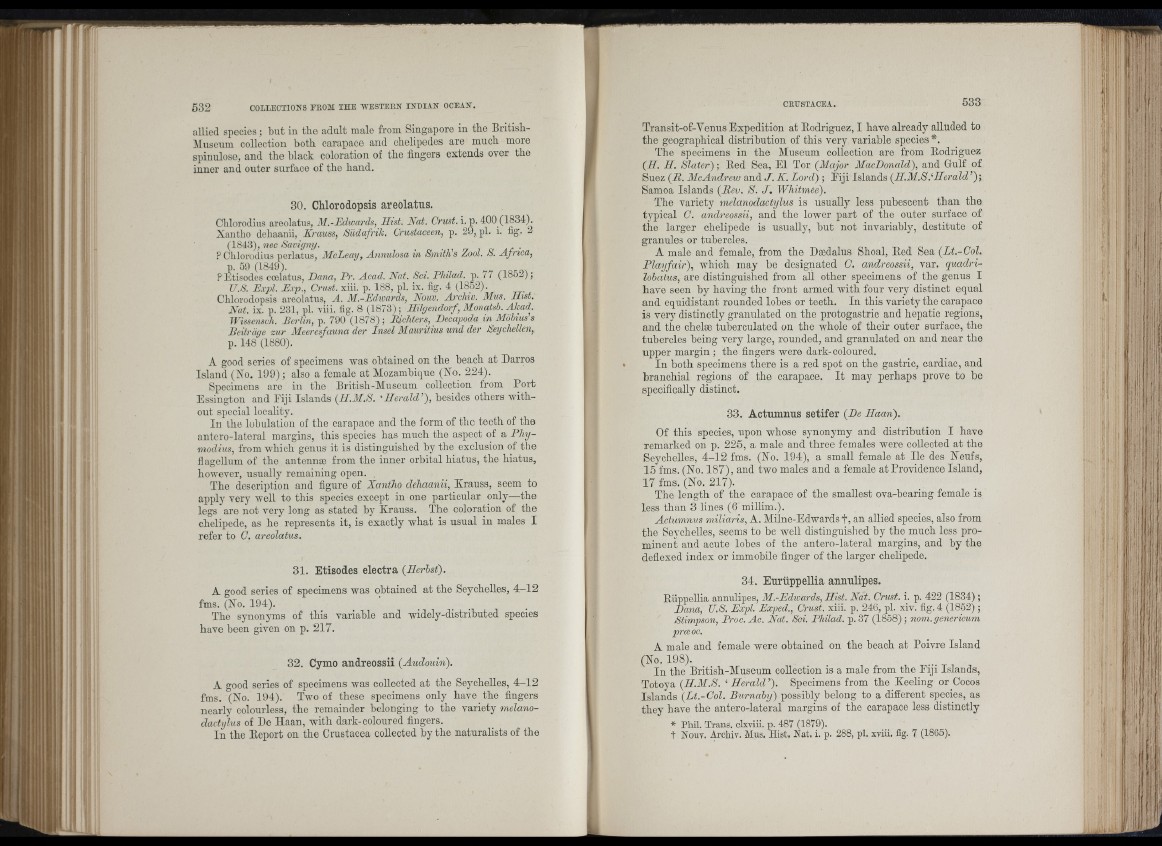
allied species; but in tbe adnlt male from Singapore in tbe Britisb-
Alnscum collection botb carapace and cbelipcdes are mucb more
spinulose, and tbo black coloration of tbe fingers extends over tbe
inner and outer surface of tbe band.
30. Chlorodopsis areolatus.
Chlorodius areolatus, M.-Edwards, Hist. Nat. Crust, i. p. 400 (1834/
Xantlio debaanii, Krauss, Siidafrik. Crustaceen, p. 29, pi. i. fig. 2
(1843), nec Savigny. _ _
? Clilorodius perlatus, McLeay, Annulosa in Smith's Zool. S. Africa,
p . 59 (1849).
? Etisodes coelatus, Dana, Pr. Acad. Nat. Sci. Philad. p. /7 (185^);
U.S. Expl. Exp., Crust, xiii. p. 188, pi. ix. fig. 4 (1852).
Chlorodopsis areolatus, A. M.-Edwards^ Nouv. Archiv. Mus. Hist.
Nat. ix. p. 231, pi. xiii. fig. 8 (1873) ; Hilgendorf, Monatsb. Akad.
Wissensch. Berlin, p. 790 (1878) ; Richters, Decapoda in Molnus s
Beiträge zur Meeresfauna der Insel Mauritius und der Seychellen,
p. 148 (1880).
A good series of specimens was obtained on tbe beach at Darros
Island (Xo. 199); also a female at Alozamhique (No. 224).
Specimens are in the Britisb-AIusenm collection from Port
Essington and Fiji Islands (H.Al.S. ‘Herald’), besides others without
special locality.
In tbe lobulation of the carapace and the form of the teeth of the
antero-lateral margins, this species has much the aspect of a Phy-
modius, from which genus it is distinguished by the exclusion oi the
flagellum of tbo antenna? from the inner orbital hiatus, tbe hiatus,
however, usually remaining open. ,
Tbe description and figure of Xantho dehaanii, Krauss, seem to
apply very well to this species except in one particular only—tbe
legs are not very long as stated by Krauss. The coloration of the
chelipede, as be represents it, is exactly wbat is usual in males I
refer to C. areolatus.
31. Etisodes electra (Herbst).
A good series of specimens was obtained at tbo Seychelles, 4 -12
fms. (No. 194).
Tbe synonyms of tbis variable and widely-distributed species
have been given on p. 217.
32. Cymo andreossii (Audouin).
A good series of specimens was collected at tbe Seychelles, 4—12
fms. (No. 194). Two of these specimens only have tbe fingers
nearly colourless, tbe remainder belonging to tbe variety melanodactylus
of De Haan, with dark-coloured fingers.
In tbe Report on tbe Crustacea collected by the naturalists of the
Transit-of-Vemis Expedition at Rodriguez, I have already alluded to
the geographical distribution of tbis very variable species *.
The specimens in tbe Aluseum collection are from Rodriguez
(H. PI. Slater) ; Red Sea, El Tor (Major MacDoncdd), and Gulf of
Suez (R. McAndrew and J . K. Lord) ; Fiji Islands (H.M.S.‘Herald’);
Samoa Islands (Rev. S. J . Whitm.ee).
Tbe variety melanodactylus is usually less pubescent than tbe
typical C. andreossii, and tbe lower part of the outer surface of
tiie larger chelipede is usually, bnt not invariably, destitute of
granules or tubercles.
A male and female, from tbe Dædalns Shoal, Red Sea (Lt.-Col.
Playfair), which may be designated 0. andreossii, var. quadrilobatus,
are distinguished from all other specimens of the genus I
have seen by having tho front armed with four very distinct equal
and equidistant rounded lobes or teeth. In tbis variety tbe carapace
is very distinctly granulated on the protogastric and hepatic regions,
and the cbelæ tuberculated on the whole of tbeir outer surface, the
tubercles being very large, rounded, and granulated on and near tbo
upper margin ; the fingers were dark-coloured.
In botb specimens there is a red spot on tbe gastric, cardiac, and
branchial regions of tbe carapace. I t may perhaps prove to be
specifically distinct.
33. Actumnus setifer (De Haan).
Of this species, upon whose synonymy and distribution I have
remarked on p. 225, a male and three females were collected at tbe
Seychelles, 4-12 fms. (No. 194), a small female at He des Neufs,
15 fms. (No. 187), and two males and a female at Providence Island,
17 fms. (No. 217).
The length of the carapace of tbe smallest ova-bearing female is
less than 3 lines (6 millim.).
Actum,nus miliaris, A. Alilne-Edwards f , an allied species, also from
the Sevcbelles, seems to be well distinguished hy tho much less prominent
and acute lobes of the antero-lateral margins, and by tbe
defiexed index or immobile finger of tbe larger chelipede.
34. Euriippellia annulipes.
Riippellia annulipes, M.-Edivards, Hist. Nat. Crust, i. p. 422 (1834) ;
Dana, U.S. Expl. Exped., Crust, xiii. p. 246, pi. xiv. fig. 4 (1852) ;
Stimpson, Proc. Ac. Nat. Sci. Philad. p. 87 (1858) ; nom. genericum
qircBOC,
A male and female were obtained ou tbe beach at Poivre Island
(No. 198).
In the Britisb-AIusenm collection is a male from the Eiji Islands,
Totoya (H.Al.S. ‘ Herald’). Specimens from tbe Keeling or Cocos
Islands (Lt.-Col. Burnaby) possibly belong to a different species, as
they have tbe antero-lateral margins of the carapace less distinctly
* Phil. Trans, clxviii. p. 487 (1879).
t Nouv. Archiv. AIus. Hist. Nat. i. p. 288, pi. xviii. fig. 7 (1865).
! 1 ri ■
rite!